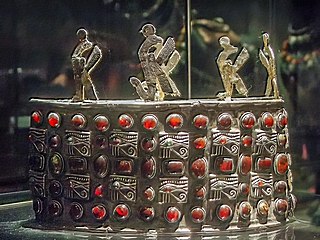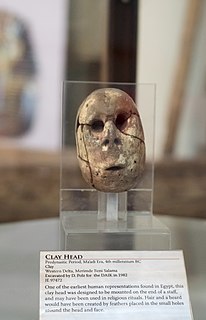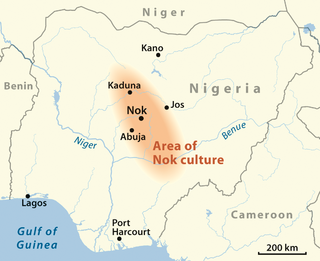 W
WTell Arpachiyah is a prehistoric archaeological site in Nineveh Province (Iraq). It takes its name from a more recent village located about 4 miles (6.4 km) from Nineveh. The proper name of the mound on which the site is located is Tepe Reshwa.
 W
WBallana was a cemetery in Lower Nubia. It was excavated by Walter Bryan Emery along with nearby Qustul between 1928 and 1931 as a rescue project before a second rising of the Aswan Low Dam. A total of 122 tombs were found under huge artificial mounds. They date to the time after the collapse of the Meroitic state but before the founding of the Christian Nubian kingdoms, around AD 350 to 600. They usually featured one or several underground chambers, with one main burial chamber. Some tombs were found unlooted, but even the robbed burials still proved to contain many burial goods.
 W
WThe Ballinderry Sword is an iron Viking-style weapon found in a bog on the site of a crannog in Ballinderry, in Rosemount, County Westmeath, Ireland in 1928. It is no. 36 in A History of Ireland in 100 Objects. It was found along with other Viking objects: a longbow, two spearheads, an axe head and a gaming board. The settlement dates from between the late 9th and early 11th century and the collection of artifacts uncovered appears to fit the profile of a wealthy Irish farmer or of a local ruler.
 W
WBeadlam Roman villa is a Roman villa on the east bank of the River Riccal in North Yorkshire, England. It is in the district of Ryedale between Helmsley and the village of Beadlam. This Scheduled Ancient Monument is the remains of a large Romano-British farm built in the third and fourth centuries AD. The site was first explored in 1928 when Romano-British tile and pot and tesserae were found. Further excavation in 1966 revealed a mosaic pavement in a building in the northern part of the site. The field in which it was found was purchased by English Heritage. More detailed excavations took place in 1969, 1972 and 1978 when the remains of buildings forming three sides of a courtyard were uncovered.
 W
WThe Merimde culture was a Neolithic culture in the West Nile Delta in Lower Egypt, which corresponds in its later phase to the Faiyum A culture and the Badari culture in Predynastic Egypt. It is estimated that the culture evolved between 4800 and 4300 BC. Merimde also refers to the archaeological site of the same name.
 W
WThe Nok culture is a population whose material remains are named after the Ham village of Nok in Kaduna State of Nigeria, where their terracotta sculptures were first discovered in 1928. The Nok Culture appeared in Nigeria around 1500 BC and vanished under unknown circumstances around 500 AD, having lasted approximately 2,000 years.
 W
WThe Prague Castle skeleton is a human skeleton that was discovered in 1928 at Prague Castle in the Czech Republic. The burial was excavated by Ukrainian-born archaeologist Ivan Borkovský as part of a Czech National Museum project. The skeleton was dated to the 9th or 10th century AD and was associated with high-value burial goods. Ethnic identification of the deceased has proved controversial.
 W
WTell el-Far'ah (South)^ is an archaeological site on the bank of HaBesor Stream in the northern Negev region, Israel. It is located between the modern settlements of Ein HaBesor and Urim, some 12 kilometres (7.5 mi) from the modern city of Ofakim and 20 kilometres (12 mi) from Gaza. It was first excavated by Flinders Petrie in 1928–1929. Petrie wrongly identified the site with Beit Pelet in the territory of the Tribe of Judah. William F. Albright identified the site with Sharuhen, which appears in Egyptian and Biblical sources. Some scholars dispute this identification.
 W
WUgarit was an ancient port city in northern Syria, in the outskirts of modern Latakia, discovered by accident in 1928 together with the Ugaritic texts. Its ruins are often called Ras Shamra after the headland where they lie.
 W
WThe Ugaritic texts are a corpus of ancient cuneiform texts discovered since 1928 in Ugarit and Ras Ibn Hani in Syria, and written in Ugaritic, an otherwise unknown Northwest Semitic language. Approximately 1,500 texts and fragments have been found to date. The texts were written in the 13th and 12th centuries BCE.
 W
WThe Uruk Trough is an important Sumerian sculpture found at the site of Uruk, Iraq. It has been part of the British Museum's collection since 1928. Along with the Uruk Vase, the trough is considered to be one of the earliest surviving works of narrative relief sculpture from the Middle East, dating to 3300-3000 BC, during the Uruk period. Simple relief sculpture is known from much earlier periods, from the site of Göbekli Tepe, dating to circa 9000 BC.